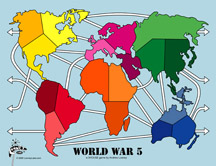 Design History
of World War 5
Design History
of World War 5
By Andrew Looney, first published in Game Trade Magazine Dec 2008
I love Risk. The classic world conquest board game was one of my earliest gaming obsessions... I have fond memories of spending the whole day playing Risk with my friends whenever school was canceled because of snow. Risk was also one of my earliest game design platforms; when I discovered the card game Nuclear War, I tinkered up a set of rules for a combination game I called Nuclear Risk.
But much as I like it, Risk has flaws. The most obvious problem is that the game is WAY too long. It takes hours and hours to play a complete game -- that's why we always needed to reserve whole days for a single game, and even then we usually couldn't finish. It's quite a challenge to totally destroy every other player, and whenever someone builds a massive army and makes a run at that victory, odds are that they'll fall short, retreat, and return to the status quo.
Risk has two distinct phases, and I like the first part best. At the beginning, everyone's pieces are deposited randomly in spaces all over the world. There's a lot of action in the preliminary rounds as each player seeks to consolidate their scattered forces and use them to conquer their first continent. In the second, much longer, phase, each player typically controls one continent (or a couple of smaller ones) and seeks to sustain that control against minor assaults while building up forces for a major assault of your own.
While my favorite part is the first phase, even there I have complaints. The Risk board has color-coded continents and players use brightly-colored game tokens, but there's no correlation between the two. It seems like the player with yellow pieces should start with all of those yellow pieces in the yellow country, right? Or perhaps the goal is for the scattered yellow army to reunite and then take over the yellow continent? But no, these are not the way things work with Risk.
Lastly of course, there's the combat system, which is heavy on the rolling of dice. Anyone who's played my games knows I'm a believer in using luck to give the underdog a chance, but every Risk player knows there are times when it's annoying that a tiny army can sometimes hold off an overwhelmingly huge one with a series of really good dice rolls.
At some point, my gaming buddies and I moved on from Risk to Diplomacy, which addresses several of these concerns. Set entirely in Europe, army (and navy) pieces start in their appropriately colored countries, and luck plays no factor at all - combat has a simple push mechanism. If my forces outweigh yours, you must move, and if there's no where for you to retreat to, your piece is destroyed.
But Diplomacy has many of the same limitations as Risk. Diplomacy games also take forever -- a single turn can typically take over an hour, depending on the amount of negotiation time the players are permitted. Of course, that's what really makes Diplomacy cool. Indeed, that's what the game is all about: making deals. But you still need to set aside a whole day for a game. Moreover, you need a big enough group; for the game to really work right, you need at least 6 players.
Anyway, for many years I've been pondering the idea of an Icehouse game that you'd play on a Risk board -- with a combat system more like Diplomacy -- but I never got anywhere with it. (There's probably still a game in there, for anyone else interested in that challenge. But I've moved on.)
The problem is with the Risk board itself. It's too big, and too imbalanced for the kind of game I wanted to make. So finally I realized that I just needed to make my own game board, which I could distort and adapt as I needed. Instead of going with the real-world constraints of differently-sized land masses and human imposed boundaries, I reshaped the world into 6 evenly sized land groupings, each divided up into 3 equally sized territories, with each continent connected to every other continent, and with all continents having an equal number of international connections. With the playing field thus leveled, I could proceed to create a vastly easier, fast-playing world conquest game. All you need is 3 Treehouse sets, 6 regular dice, and my little world map gameboard.
As with all of my best game designs, this one congealed very quickly, going from design breakthrough to finished ruleset in just under two weeks.




